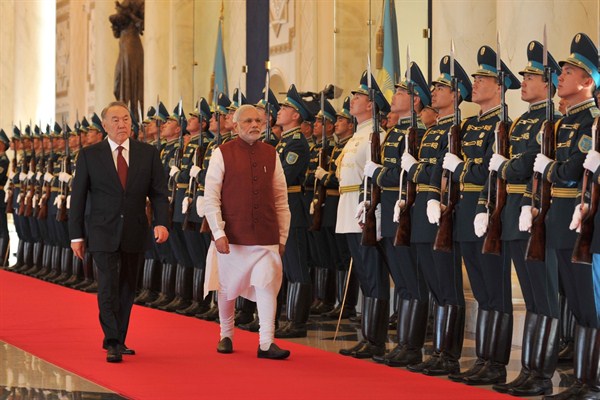Indian Prime Minister Narendra Modi’s whirlwind tour this month of the five Central Asian republics of Uzbekistan, Kazakhstan, Turkeminstan, Kyrgyzstan and Tajikistan, with a stop in the middle in Russia, was a move to breathe life into the “Connect Central Asia” strategy launched under Modi’s predecessor, Manmohan Singh, in 2012. Modi’s renewed seriousness about an Indian foreign policy that looks north is underscored by India’s investment in the Iranian port of Chahbahar. The port forms the southern end of the International North-South Corridor (INSTC), a multination rail, road and shipping network connecting India with Russia via Central Asia. But this key piece in India’s plans also reveals New Delhi’s dependence on Iran in achieving its goals in Central Asia.
India wants to expand that trade corridor as a gateway to Central Asia and Russia, bypassing Pakistan. To do so, India plans to link the INSTC with other projects in the region, such as the 2011 Ashgabat Agreement to develop a transit corridor initially connecting Uzbekistan, Iran, Turkmenistan and Oman. The agreement has since expanded to include Kazakhstan and, perhaps in the near future, India, which has expressed interest in joining. India wants to emerge as an alternative market for Central Asia, even as China looks to cement its economic primacy in the region via its massive, so-called One Belt One Road infrastucture and trade initiative in Eurasia. India’s engagement in Central Asia is also aimed at strengthening multilateral security ties, as evidenced by India’s pending entry into the Shanghai Cooperation Organization (SCO) at a time when new unrest in Afghanistan is stoking more Islamic terrorism and drug trafficking.
Uzbekistan, the most populous of the Central Asian republics and a country that sees itself as a natural leader in the region, was Modi’s first stop. Modi stressed that beginning his journey in Uzbekistan “underlined its importance for India, not just in the context of this region, but also more broadly in Asia.” Symbolism aside, India and Uzbekistan realize they need to add economic depth to their strategic partnership. Discussions during the visit focused on removing hurdles to Indian investment in Uzbekistan’s agriculture and energy sectors that could increase related exports to India. Uzbekistan is already India’s main counterterrorism partner in the region; closer intelligence cooperation on the Taliban and Pakistan, as well as on new players entering Afghanistan like the self-declared Islamic State, is on the table.

